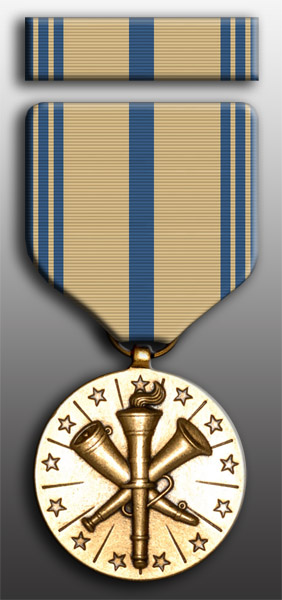
|
Armed Forces Reserve Medal
and Ribbon Set
|
For award to military personnel whose Reserve Component service has been primarily in the organized Reserve or in the National Guard. Service must be honorable for a period of 10 years within a 12 consecutive year period of time.
First Lieutenant Audie Murphy was transferred into U.S. Army Officers' Reserve Corps on an inactive duty status as of September 22, 1945 following his return to Texas shortly after the end of World War II. He would remain inactive for five years until July 13, 1950.
During this time Murphy was never interested in severing all ties with the military. Instead, he occassionally attended military-style functions in uniform. He was well-noted for his ability to speak, smile, and shake hands and the military frequently asked him to participate in public relation events. The fact was that Murphy enjoyed his association with soldiers and his remaining connections with the army. He was "reluctant to part with everything associated with the Army" (Simpson, page 339).
In 1950, Murphy was approached by two former World War II military associates who were trying to reorganize the 36th Infantry Texas National Guard Division. Major General H. Miller Ainsworth, the Commander of the 36th Infantry Division, and Brigadier General Carl L. Phinney, the division's Deputy Commander believed Murphy's prestige and notoriety could help. They had no trouble recruiting Murphy to join the "T-Patch" division (Simpson, page 339-340).
On July 14, 1950, after receiving orders from the Adjutant General of Texas, Audie Murphy reported for a physical examination at Camp Mabry, Austin, Texas. Several hours later, he was sworn in as a captain in the Texas National Guard (Simpson, page 341).
Murphy was also concerned about the situation in Korea and that another world war would soon break out. He was also convinced that the 36th Infantry Division would be needed in Korea and would soon be called up.
Murphy trained and worked with the National Guard as his Hollywood schedule allowed him. Overall, he completed four two-week summer training sessions and participated a few days in each of several other summer training events. He also conducted many company level inspections and visited small units in the 36th Infantry Division throughout the state of Texas (Simpson, page 342).
He was actively associated with the Texas National Guard from July 14, 1950 until October 10, 1951. He was then inactive between October 11, 1951 until July 7, 1955. He then became active again on July 8, 1955 and remained in this status until June 30, 1957. From July 8, 1955, until June 30, 1957 he was again on an inactive status. Murphy remained inactive in the Texas National Guard from July 1, 1957 until February 7, 1966.
Audie Murphy was also promoted in the Texas National Guard to the grade of Major as an Infantry officer on February 14, 1956. This promotion was federally recognized which meant that if Murphy was ever called up for federal service, his promotion would be recognized as equivalent to that of any other regular U.S. Army officer.
On February 8, 1966, Major Audie Murphy ended his association with the Texas National Guard and entered inactive U.S. Army Reserve status until May 21, 1969. The following day, on May 22, 1969, he was placed in the U.S. Army Retired Reserve and remained so until his death on May 28, 1971.
| 






